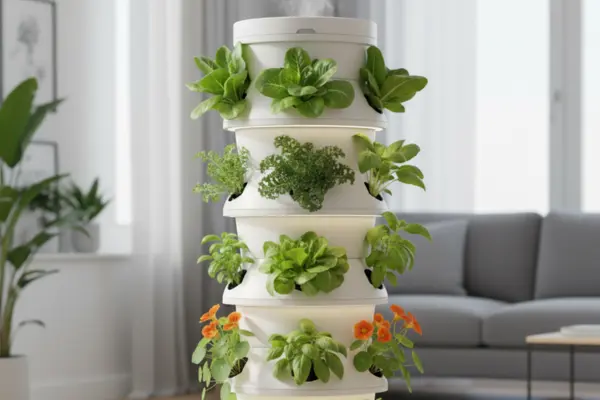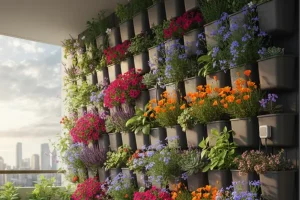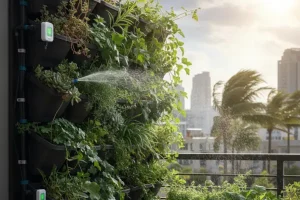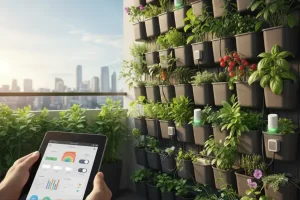Introduction
Vertical tower gardens are a smart way to grow fresh produce in tight spaces. With plants stacked upward, you can turn a balcony, patio, or even a sunny indoor corner into a miniature farm. But while these systems are efficient and visually striking, beginners often stumble over the same mistakes.
The good news? Most problems are easy to fix once you know what to look for. In this guide, we’ll cover the five most common vertical tower system mistakes and show you exactly how to correct them, so your garden thrives year-round.
Why It Matters
A vertical tower system looks simple, but it relies on consistent water flow, nutrient balance, and proper spacing. Overlooking even one element can lead to stunted plants, clogged pumps, or wasted effort. By learning from these common missteps, you’ll save time and enjoy healthier harvests.
Mistake 1: Overcrowding Plants
The problem: It’s tempting to plant as much as possible in each pocket of your tower. Unfortunately, overcrowding reduces airflow, increases humidity, and blocks light, all of which encourage disease.
The fix:
- Follow spacing guidelines (typically 6–12 inches between plants).
- Rotate crops so larger plants do not overshadow smaller ones.
- Harvest regularly to prevent overgrowth.
Best crops for towers: Lettuce, basil, mint, kale, strawberries. Avoid heavy, sprawling plants like pumpkins or corn.
Mistake 2: Poor Water Circulation
The problem: Weak or clogged pumps can cause uneven watering. Plants at the top may thrive while those at the bottom dry out—or worse, roots may rot in stagnant water.
The fix:
- Clean pumps, filters, and tubing every two weeks.
- Test water flow by checking all levels of the tower.
- Keep a backup pump ready in case of failure.
Mistake 3: Ignoring pH and Nutrient Levels
The problem: Even with consistent watering, plants can struggle if the water chemistry is off. Yellowing leaves, weak growth, or poor yields often signal pH or nutrient imbalances.
The fix:
- Use a digital pH meter weekly.
- Aim for a pH of 5.5–6.5 (ideal for most vegetables and herbs).
- Monitor electrical conductivity (EC) to ensure proper nutrient strength.
- Use premixed hydroponic nutrient solutions for simplicity.
Mistake 4: Choosing the Wrong Crops
The problem: Not all plants thrive in vertical towers. Large, fruiting plants put too much stress on the system, leading to frustration.
The fix:
- Select crops suited to tower systems: lettuce, spinach, kale, basil, mint, oregano, and strawberries.
- Choose dwarf or compact varieties when possible.
- Grow large crops like tomatoes or peppers in separate containers nearby.
Mistake 5: Forgetting Seasonal Adjustments
The problem: Treating your tower the same year-round can stress plants. Heat, cold, and changing light conditions all affect performance.
The fix:
- In summer: Increase watering frequency, provide shade cloth if needed.
- In winter: Reduce watering, add grow lights indoors, and insulate the reservoir against cold.
- Transition crops seasonally (cool-weather greens in fall, heat-tolerant herbs in summer).
Quick Troubleshooting Table
| Symptom | Likely Cause | Solution |
| Yellow leaves | pH imbalance or nutrient deficiency | Test and adjust solution |
| Plants drooping at bottom | Weak or clogged pump | Clean or replace pump |
| Mold or mildew | Poor airflow, overcrowding | Thin plants, improve ventilation |
| Roots slimy | Overwatering or poor drainage | Shorten watering cycles |
| Uneven growth | Light or water imbalance | Rotate plants, adjust pump flow |
FAQs
Can I use soil in a vertical tower system?
Most towers are designed for hydroponics or aeroponics, not soil. Soil clogs the system and prevents proper water flow.
How often should I change the nutrient solution?
Every two to three weeks is recommended. Always flush the system before refilling.
Do I need grow lights?
If your tower is indoors or in a shaded area, yes. Outdoors in full sun, supplemental lighting is not necessary.
Can vertical towers work year-round?
Yes, with adjustments. Indoors, you’ll need grow lights during winter. Outdoors, you may need to protect against frost or heat.
What pH should I keep for my nutrient solution?
Aim for a pH of 5.5–6.5 (sweet spot around 5.8–6.2). Test 2–3 times a week—especially after top-ups—and adjust with pH up/down so nutrients stay available and roots stay healthy.
Next Steps & Related Reading
To avoid additional problems, consider Automating Your Vertical Garden: Timers, Pumps & Controllers, which explains how to set up an automated system for consistent watering and lighting.
If you’re interested in building your own system, take a look at Low-Cost Vertical Garden Systems You Can Build in a Weekend for budget-friendly DIY ideas.
Conclusion
Vertical tower gardens are one of the most efficient ways to grow food at home, but like any system, they require care and attention. By avoiding these five common mistakes—overcrowding, poor water flow, ignoring pH, planting unsuitable crops, and neglecting seasonal adjustments—you can create a system that produces fresh, healthy harvests year-round.
Which of these mistakes have you run into in your gardening journey? Share your experience and tips in the comments below.




